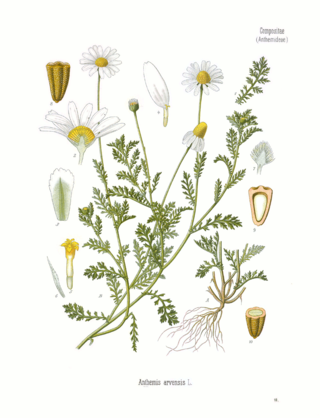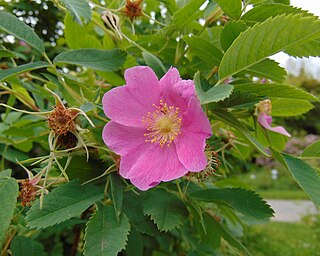Related Research Articles

Phleum (timothy) is a genus of annual and perennial plants in the grass family. The genus is native to Europe, Asia and north Africa, with one species also in North and South America.

Anthemis arvensis, also known as corn chamomile, mayweed, scentless chamomile, or field chamomile is a species of flowering plant in the genus Anthemis, in the aster family. It is used as an ornamental plant.

Caragana is a genus of about 80–100 species of flowering plants in the family Fabaceae, native to Asia and eastern Europe.

Juncus bufonius, known commonly as toad rush, is a widespread flowering plant species complex in the rush family Juncaceae.

Halodule is a genus of plants in the family Cymodoceaceae described as a genus in 1841. It is widespread on tropical and semi-tropical ocean shores of all continents except Europe and Antarctica.

Pakistan's native flora reflects its varied climatic zones, which range from arid and semi-arid to temperate and tropical.

In Pakistan, more than 430 tree species are distributed over 82 families and 226 genera. Out of these, 22 species from 5 families and 11 genera belong to softwood trees of gymnosperms. For all plant families found in Pakistan, see Flora of Pakistan.

Hygroryza (watergrass) is a monotyipic genus of Asian flowering plants in the grass family. The only known species is Hygroryza aristata, native to China, Bangladesh, Cambodia, India, Laos, Malaysia, Myanmar, Nepal, Pakistan, Sri Lanka, Thailand, Vietnam.

Zinnia peruviana, the Peruvian zinnia, is an annual flowering plant in the family Asteraceae. It is native to North America and South America.

Allium macleanii is an Asian species of wild onion found at high elevations in Pakistan, Kazakhstan, Turkmenistan, Kyrgyzstan, Afghanistan, Nepal, Tajikistan, and northern India. It is a perennial herb up to 100 cm tall, with a spherical umbel up to 7 cm in diameter. The umbel is crowded with many purple flowers.

Sagittaria ambigua, the Kansas arrowhead, is an aquatic plant species native to North America. It is a perennial herb growing up to 90 centimetres tall. The leaves are broadly lanceolate, the blade up to 20 cm (8 in) long and 12 cm wide.

Apocynum venetum, commonly known as sword-leaf dogbane, is a plant species in the dogbane family that is poisonous but used as a source of fiber, medicine, and nectar for production of honey.
Iris kobayashii is a beardless iris in the genus Iris, in the subgenus Limniris and in the series Tenuifoliae of the genus. It is a rhizomatous herbaceous perennial, from China. It has slightly twisted leaves, short stems and 1 to 2 purple or blue and yellow flowers.

Fritillaria gibbosa is a species of herbaceous perennial plant in the lily family Liliaceae. It is native to Afghanistan, Iran, Pakistan, Turkmenistan, and Transcaucasia.

Leontopodium jacotianum is a species of plant in the family Asteraceae. It is native to Bhutan, China, India, Myanmar and Pakistan.

The Ziarat Juniper Forest is a juniper forest in Ziarat, Balochistan, Pakistan.
Caragana korshinskii, also known as the Korshinsk pea shrub, is a shrub from the genus Caragana. The plant is native to sandy grass and desert areas of northern China and Mongolia. This plant is classified as an invasive species and is a minor host of Scolytus schevyrewi. Caragana Korshinskii is utilized in Northern China for both the fixation of sand and soil/water conservation. This plant is found in desert regions of China and is adapted to suit that environment. This adaption is seen in its ability to survive under conditions prone to salty, cold, and dry conditions.

Rosa webbiana, occasionally called Webb's rose, wild rose, or thorny rose, is a widely distributed species of flowering plant in the family Rosaceae. It is native to Central Asia, Tibet and Xinjiang in China, Afghanistan, Pakistan, the western Himalayas, and Nepal. It grows in scrub, grassy places, valleys, and slopes. A diploid, its chromosome count is 2n = 2x = 14.

Rhododendron anthopogon, the dwarf rhododendron, is a species of flowering plant in the family Ericaceae, native to Pakistan, the Himalayas, Tibet, and Myanmar. It is used to make an essential oil. Its habitats include open slopes, thickets, hillsides, and cliff ledges.

Thingia is a monospecific genus of flowering plant in the family Montiaceae comprised only by the species Thingia ambigua, known as desert pussypaws. It is native to northwestern Mexico, California, and Arizona, and is found commonly on sandy or silty soil. The sole species of the genus has been housed under several genera before it was split into Thingia: Claytonia in 1882, Calandrinia in 1893, and Cistanthe in 1990. DNA evidence demonstrated that the relationship of Thingia ambigua, then Cistanthe ambigua, to the next closest relative in Cistanthe, C. tweedyi, was actually disjointed. It was found that the two species were most closely related to completely separate South American taxa.
References
- ↑ "Caragana ambigua in Flora of Pakistan @ efloras.org". www.efloras.org.
- ↑ Rubab, Faryal; Ijaz, Hira; Hussain, Shah; Munir, Ans; Stuppner, Stefan; Jakschitz, Thomas; Bonn, Günther K; Ishtiaq, Saiqa (December 18, 2022). "Gastroprotective effects of Caragana ambigua stocks on ethanol‐induced gastric ulcer in rats supported by LC–MS/MS characterization of formononetin and biochanin A". Journal of the Science of Food and Agriculture. 102 (15): 7030–7038. doi:10.1002/jsfa.12064. PMC 9795896 . PMID 35689485.